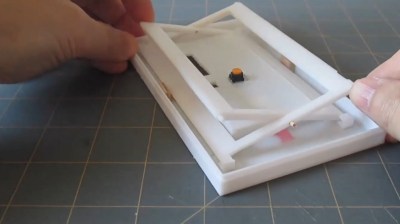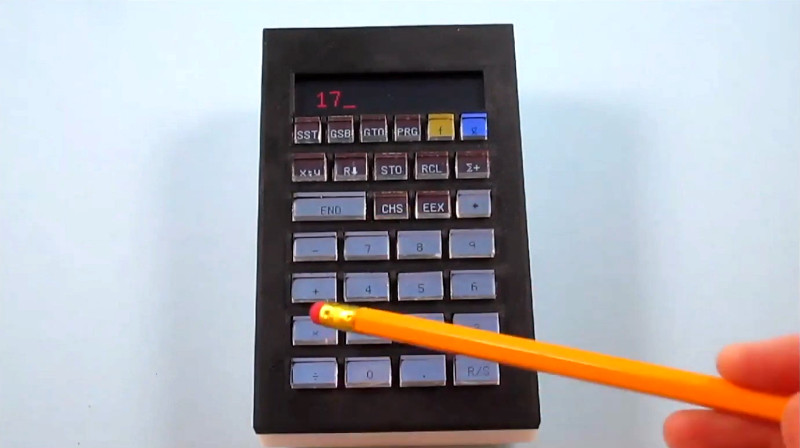We’ve all heard it a thousand times – they don’t make ’em like they used to. Sometimes, that’s for good reason, but there is a certain build quality to electronics of the mid-20th century that is hard to find in hardware today. This inspires great nostalgia and dedication in some, like [Michael Park], who set out to build a calculator reminiscent of the best HP designs from yesteryear.

One of the major factors for [Michael] was the great feel of the keys on these classic units. Wanting to experiment with different layouts without a lot of rewiring, the idea of keys with individual displays became attractive. Existing parts on the market were prohibitively expensive, however. Instead, [Michael] used a single touchscreen with a switch mounted underneath to provide tactile feedback with a nifty scissor-arm guide mechanism. Combined with individual see-through plastic overlays, the MP-29 has a fully reconfigurable pad of 30 keys with dynamically updatable labels.
It’s a creative choice, and one that looks highly satisfying to use. It has all the tactile benefits of individual keys, both in the keypresses and being able to navigate the keypad without looking. Combined with the benefit of reconfigurable keys thanks to the touch screen underneath, it’s a great way to build a user-interface.
The rest of the calculator design closely mimics the HP-29, though [Michael] is also experimenting with alternative layouts too. There are plenty of religious wars in the calculator community over usability, after all – mostly over which side of the pad has the arithmetic functions.
We’ve lamented the demise of the standalone calculator recently; with so many smart devices around, it’s hard to see it making a major comeback anytime soon. Of course, if you’re opinionated on the topic, sound off in the comments below. Video after the break.
















Cool idea! I think one might also be able to build some kind of tactile mechanism to the transparent buttons directly, which would make this much easier to install on top of an existing touchscreen. Add some conductive material to trigger the capacitive touchscreen and you could just put a keyboard on top of an old smartphone.
Same though, I wonder whether you could get away without the scissors mechanism by using a touch screen / digitizer between the display and the keys, perhaps of the older resistive kind. If it were to work with a capacitive screen, I also wonder if it would be possible to produce a transparent acrylic keypad that fits over a smartphone and get similar results.
That’s exactly what it does. The (single) switch behind the screen on the scissor mechanism is purely there to get the tactile ‘click’.
I suspect the touchscreen won’t have a long life being constantly pressed in exactly the same position for each button by a sharp bit of acrylic though…
Thanks, I completely missed that bit. You are right about the life of the display, perhaps the keys are not that sharp. The bottom of the key needs to be flat for optical reasons, but outside the display area they could be rounded off to be more gentle on the display. Still wondering if it would work on capacitive displays and smartphones; that would definitely be more durable.
At least on the capacitive digitizers I have lying around, any substantial thickness of acrylic makes it totally useless.
Ivan: capacitive touch sensors can easily detect hits 6mm away from the electrodes. The sensitivity is set in firmware, and most touchscreens have this set to where there has to be more contact area on the user’s fingertip, which requires a slight amount of pressure. This is intentional, since people get annoyed when the device reacts before they’ve even made contact. Note also that on many devices, the pointer will move before you make contact. This is because the sensitivity can be set differently for tracking vs. activation.
But none of that matters for this case, because the touchscreen is of the resistive type.
Ugh. I missed that, too. Tactile feedback is USELESS if it does not positively indicate that the device has accepted your input. Useless.
This is exactly how the elgato streamdeck works, it has a bunch of clear acrylic buttons, which have a conductive rubber around them, and they then contact a capacitive touch screen below that you can customise from some PC software
OMG. No, I’m not going to watch for half an hour to learn what this guy has to say. Thank YouTube for the playback speed feature.
There are two objections I have to this design:
1) In pressing any key, you’re having to press against the inertia of the buttons and the LCD panel, combined. This seems like a lot, making keying more sluggish than with individual switches.
2) If I tend to rest all of the fingers of one hand on the keypad, as I do, since I’m a touch typist, and this helps to keep track of where the keys are without looking at them, then all of those fingers are going to be detected by the toucscreen.
It reminds me a little of one of the buttonless Apple mice from the early teens. These had no buttons on them, but when you pressed on it, you got tactile feedback because the upper housing was separated from the bottom housing, by a mechanism that activated a tactile switch. It was able to distinguish left from right presses by using a capacitive sensor under the right side of the upper housing. This worked because (right-handed) people almost universally raise their index finger when right-clicking.
What I DO like is the idea of being able to change the captions under each keycap, without the expense of individual LCDs for each key. So maybe another possibility is to place a transparent array of keyswitches on top of an LCD panel. There are some very small tact switches available these days. I just bought some that were 4x3x2 mm, which turns out to be much smaller than I had visualized, that I think would be great for this. And now I’m thinking that for a 40% keyboard, two 5″ LCDs could be placed side-by-side, to show the characters available in the current keyboard state. Hmmm.
Also, transparent acrylic buttons have always looked cool.
Lenovo made exactly this mistake with the T440 touchpad, completely useless, I need physical buttons and it was clear almost everybody wanted that so the next Thinkpad iteration had a normal button touchpad again.
I however like the creativity and reconfigurability.
Haha, I had my t440s for less than a weeo bwfore I’d ordered a t450s pad, then i got a t450s whole bottom half (turns out it had a faulty heatpipe), and swapped to that (faster IGP XD)
I think Youtube prefers the longer format videos these days. I’ve noticed a lot of my usual channels are now waffling a lot more unnecessarily to fill the time.
YouTube prefers videos with longer WATCH times, not longer overall times. But I don’t think this was a case of someone trying to game YouTube – it was a Zoom meeting, not a targeted video with any particular editing.
For the other three people who have listened all the way to the end, the last question in the Q&A section concerned battery life, which the maker admits he is disappointed with. He’s using a single Li-ion cell, and was expecting that it would last at least a week in sleep mode, but finds that the battery is dead after two or three days.
This is probably due to the DC to DC converter he is using. Makers of DC to DC converters are always happy to tell your their peak efficiency, which is generally in the 90-95% range. What they are less eager to talk about is the continuous no-load current. A 2.5 A*hr cell running a DC-DC converter with 50 mA of idle current will run for 50 hours, and this is probably close to the situation he has here.
I personally prefer a dedicated calculator above a computer or smart phone to be fair.
Mainly since touch screens on phones doesn’t have the same key density as actual keys. (mis-clicks are annoying.)
Though, a lot of the more advanced graphic calculators aren’t all that ideal to be fair.
Since most calculators tends to remove one’s actual equation and just present the answer, or require some quirky method of bringing the equation back for one to edit, not to mention that editing itself at times is quirky.
Though, found some random “Olympia LCD8110” for 2€ at the local store likely over a decade back… And it has worked admirably. A bit limited in its resolution (it’s like 12 digits, displays 9), editing the equations on it isn’t flawless, but at least it is trivial and it has all the functions I need. And unlike my Ti 82, it doesn’t eat through batteries on a yearly basis.
And if one really needs to make more complex calculations, then a spreadsheet or Wolfram alpha are handy tools.
I’ve wondered before if a different kind of “tactile” feedback on a glass screen could be provided by tiny electrical shocks from the center of each key.
matlab or other calculator need more lines. meybe 2-3?
and meybe more thicknes and solar panel
everytjing other are ok
And maybe color, so multiple curves plotted together can be shown, and a bigger screen, also for plots. And a full keyboard, so that algebraic equations can be entered. And WiFi, so when you can’t remember the formula you need, you can Google it.
Cool, with a little modification I can finally have a push button phone again!
Memories of the BlackBerry Storm…
https://www.engadget.com/2008-11-22-blackberry-storms-clickable-screen-and-the-rest-of-it-dissect.html
Thanks to Lewin Day for a nice write-up! I just want to know if anyone got my little joke @ 9:30.
Well, SOMEONE did, because there was a comment making a play on that, but it seems to have disappeared. Thank you, WordPress.
Btw, thanks for the info about DC converters.
There might be some confusion about the switch behind the touchscreen. It does more than provide the clicky feedback; it is also connected to the processor. The touchscreen detects touches with low force, but it isn’t until there’s enough force to close the switch that a “keypress” is registered.
I’ll also note that I used a “soft” tactile switch with (relatively) long travel. Typical tact switches don’t have enough travel for a satisfying feel, imho.
I find using the tactile touchscreen, even without physical keys, much more pleasant than tapping on glass, though as you surmised, the inertia of the screen does hinder rapid keying. Also, 2-key rollover is impossible. However, my primary interest was in experimenting with a “dynamic key” user interface and this tactile touchscreen was just my hack around current technological limitations. Any resemblance to a practical calculator is purely coincidental.
I agree that buttons need to be tactile, but not touch sensitive for resting fingers.
I love my hp48sx for 30 years, BUT I will release a video soon on the new kid in town !! It’s incredible! My daughter introduced me to it!
Oh heck, I’ll just release the video now!
https://youtu.be/JUA7Z36RbsI